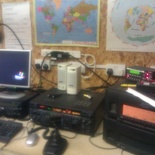Passed my radio exams today and I am on the way into obtaining my official callsign from Ofcom in a few days time!
Ham radio is something greatly enjoyed by both the young and old here in the UK. In other to operate radio equipment legally here, you have to pass the first of 3 exams (foundation, intermediate and advanced), with each increasing level of difficulty giving you access to more bands as well as increased transmission power. The foundation level was written in a way so that people across all ages can get started on amateur radio, whether they are young school children/outdoor boy scouts to retirees looking to start a new hobby.
The radio exam set by Ofcom themselves, which is the wireless regulation authority Office of Communications here in the UK (which is synonymous to the FCC in the US and IDA in Singapore). Anyone can get on air with a radio, but it’s the education and understanding that comes with the license that makes our airwaves a more friendly place to be in.
I took both the foundation and intermediate level exams back-to-back in one sitting which I passed reasonably well despite not actually being able to seriously spend time studying for it, given my hectic college term-time schedule. But my exam was actually pretty easy- completing the exam in less than a third of the allocated exam time. Even the examiner (who is also a Cambridge alumni) jokingly remarked that the Ofcom should set much harder questions specifically for Cambridge students as we always take it too easy. Now, I am certified to the intermediate level at 50W Tx!
On top of your written exam, the foundation (beginner) and intermediate radio certification levels requires a practical assessments, which are usually conducted by your local radio club. In my case I was assessed by the Wireless society senior, Mr Martin, we saw me through both my foundation and intermediate practicals in one afternoon sitting. On the foundation level, topics of proper radio use were taught on a more hands-on level, specifically making local and overseas UHF/VHF/HF contacts using the club call-sign while supervised. Here you are taught to do Morse codes, explain antenna theory, propagation and troubleshoot electromagnetic compatibility. Key things taught are the proper band-plans, power levels for transmission as well as appropriate discipline on the air.
The intermediate level has more of a technical focus as you are allow to build and operate your own design of radio equipment, thus you are expected to build a working radio-related circuity/board from scratch, as well as perform basic circuit demonstrations such as transistors, wiring plugs and setting up PL259 cables etc.
For me, being a ham is pretty much a hobby, also so that I could integrate for RF communications in my personal electronics projects I build for my home automation projects.
Also, one thing I find rather attractive ham radio now is the presence of budget transceivers provided for by many Chinese brands (such as Baofeng & Wouxun). No longer you need to spend at least $500 to $600 on equipment from the “Big 3” (Yaesu, Kenwood, Icom) but of course these cheap radios do suffer from a considerable frequency shift at higher bands, (presumably from dodgy high-pass filters) as well as urban interferences. But you do get what you pay for. But for a newbie starting up, a cheap china hand-held is more than sufficient for a “buy and throwaway” radio which you could literally trash on your early ham-years before deciding on what type of equipment is actually more suited for you. Alternatively, you can build your own radio.
Too bad this won’t be a hobby I can bring back or see flourishing in Singapore. I was told by some Singaporean hams that the current amateur radio scene is not as friendly or integrated back in Singapore, it’s more of an old-boys club with big divides between the old generation and younger ones, something completely the opposite here in the UK. Being a Ham in the UK is free for life, but in Singapore you have to pay a $50 annual fee to “join the club”. Moreover, the strict wireless regulations set by the IDA in Singapore are too restrictive and technical to consider it much of a casual hobby. You can’t simply invent or use your own designs without being put off by countless regulations, paperwork, forms and testing, which in my opinion completely destroys the pure essence of inventorship and innovation.
But anyway, I guess youngsters in Singapore can’t really be bothered with science experiments and radio in general, given the evident alternative of the mobile phone (which can can somewhat consider a form of destructive innovation). After all, unlike the latest iPhone or iPad, a handheld radio transceiver is not something people will get a kick in showing-off in materialistic Singapore, nor play Angry birds on!
If things goes according to plan, I will be going for the highest (advanced) certification exam in January, where I will be allowed to transmit at 400W as well as operate globally in CEPT approved countries.


Recently I helped my Dad buy a 7mhz radio kit and stumbled upon a SDR kit radio on ebay. That led me to the sdr-rtl blog website and purchasing a sdr-rtl V3 dongle. Just set that device for my Dad and using his diy antenna, he can receive may HF signals. The HDSDR software is pretty interesting and cool and free to use. A $30SGD USB dongle with a Windows PC is transformed into a powerful spectrum scanner/receiver!